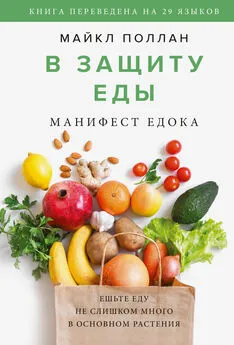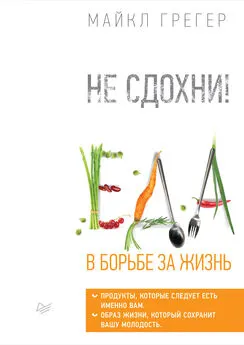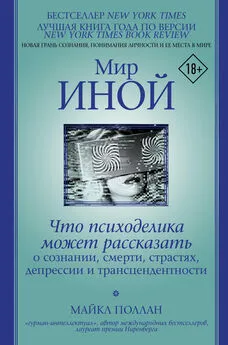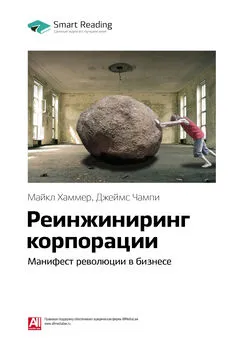Майкл Поллан - В защиту еды. Манифест едока
- Название:В защиту еды. Манифест едока
- Автор:
- Жанр:
- Издательство:Литагент МИФ без БК
- Год:2021
- Город:Москва
- ISBN:9785001696513
- Рейтинг:
- Избранное:Добавить в избранное
-
Отзывы:
-
Ваша оценка:
Майкл Поллан - В защиту еды. Манифест едока краткое содержание
Майкл Поллан призывает перестать изучать списки труднопроизносимых ингредиентов на упаковках, отказаться от модных диет и заново разобраться, что же такое правильное питание. Следуя его простым советам, вы сможете составить оптимальный именно для вас рацион, чтобы поддерживать хорошее самочувствие и быть счастливыми.
На русском языке публикуется впервые.
В защиту еды. Манифест едока - читать онлайн бесплатно ознакомительный отрывок
Интервал:
Закладка:
Simopoulos, Artemis P. “The Mediterranean Diets: What Is So Special About the Diet of Greece? The Scientific Evidence.” Journal of Nutrition. (American Institute for Cancer Research 11th Annual Research Conference on Diet, Nutrition and Cancer, Washington, D.C., July 16–17, 2001): 3065S–3073S.
Simopoulos, Artemis P., and Jo Robinson. The Omega Diet: The Lifesaving Nutritional Program Based on the Diet of the Island of Crete (New York: HarperCollins, 1998).
Trichopoulou, A., and E. Vasilopoulou. “Mediterranean Diet and Longevity.” British Journal of Nutrition. 84 suppl. 2 (2000): S205–S209.
Unlu, Nuray Z., et al. “Carotenoid Absorption from Salad and Salsa by Humans Is Enhanced by the Addition of Avocado or Avocado Oil.” Journal of Nutrition. 135 (2005): 431–436.
van het Hof, Karin H., et al. “Dietary Factors That Affect the Bioavailability of Carotenoids.” Journal of Nutrition. 130 (2000): 503–506.
Willett, Walter C. “Diet and Health: What Should We Eat?” Science. 264.5158 (1994): 532–537.
О пище, подвергающейся существенной технологической обработке, и об официальных заявлениях, согласно которым тот или иной современный продукт особо полезен для организма:
Barrionuevo, Alexei. “Globalization in Every Loaf.” The New York Times (June 16, 2007). Очень интересный взгляд на «белый хлеб из цельного зерна» марки Sara Lee. Также рекомендую этот сайт: www.thejoyofeating.com/.
Erdman, John W., et al. “Not All Soy Products Are Created Equal: Caution Needed in Interpretation of Research Results” (Fifth International Symposium on the Role of Soy in Preventing and Treating Chronic Disease, American Society for Nutrition Sciences, 2004).
Holvoet, Paul, et al. “Circulating Oxidized LDL Is a Useful Marker for Identifying Patients with Coronary Artery Disease.” Arteriosclerosis, Thrombosis, and Vascular Biology. 21 (2001): 844–848.
Hur, S.J., et al. “Formation of Cholesterol Oxidation Products (COPs) in animal products.” Food Control. 18 (2007): 939–947.
Lesser, L.I., D.S. Ludwig, et al. “Relationship Between Funding Source and Conclusion Among Nutrition-Related Scientific Articles.” Public Library of Science. 4.1, e5 doi: 10.1371/journal.pmed.0040005(2007).
Martin, Andrew. “Makers of Sodas Try a New Pitch: They’re Healthy.” The New York Times (March 7, 2007).
Messina, Mark J. “Legumes and Soybeans: Overview of Their Nutritional Profiles and Health Effects.” American Journal of Clinical Nutrition. 70 (1999): 439S–450S.
Pie, Jae Eun, et al. “Evaluation of Oxidative Degradation of Cholesterol in Food and Food Ingredients: Identification and Quantification of Cholesterol Oxides.” Journal of Agriculture and Food Chemistry. 38 (1990): 973–979.
Ravn, Karen. “Corn Oil’s ‘Qualified Health Claim’ Raises Eyebrows.” Los Angeles Times (April 16, 2007).
Staprans, Ilona, et al. “The Role of Dietary Oxidized Cholesterol and Oxidized Fatty Acids in the Development of Atherosclerosis.” Molecular Nutrition and Food Research. 49 (2005): 1075–1082.
Tenbergen, Klaus. “Dough and Bread Conditioners.” Food Product Design – Culinary Connection. http://www.foodproductdesign.com/archive/1999/1199cc.html.
U.S. FDA. Qualified Health Claims: Letter of Enforcement Discretion – Corn Oil and Oil-Containing Products and a Reduced Risk of Heart Disease (Docket No. 2006P-0243). http://www.cfsan.fda.gov/~dms/qhccorno.html.
U.S. FDA. Letter responding to health claim petition dated August 28, 2003: Monounsaturated Fatty Acids from Olive Oil and Coronary Heart Disease (Docket No. 2003Q-0559). http://www.cfsan.fda.gov/~dms/qhcolive.html.
Warner, Melanie. “Science’s Quest to Banish Fat in Tasty Ways.” The New York Times (August 11, 2005).
О диетах, предписывающих потребление преимущественно растительной пищи, и о мясных продуктах:
Appel, Lawrence J. “A Clinical Trial of the Effects of Dietary Patterns on Blood Pressure.” The New England Journal of Medicine. 336.16 (1997): 1117–1124.
Campbell, T. Colin, and Thomas M. Campbell II. The China Study (Dallas: BenBella Books, Inc., 2006).
Cho, Eunyoung, Sc.D., et al. “Red Meat Intake and Risk of Breast Cancer Among Postmenopausal Women.” Archives of Internal Medicine. 166 (2006): 2253–2259.
Gardner, Christopher D. “The Effect of a Plant-Based Diet on Plasma Lipids in Hypercholesterolemic Adults.” Annals of Internal Medicine. 142 (2005): 725–733.
Greene, Kelly. “Aging Well: How to Eat Meat and Still Feel as Healthy as a Vegetarian.” Wall Street Journal (October 21, 2006).
Heber, David. What Color Is Your Diet? (New York: ReganBooks, 2001). Блестящая дискуссия об антиоксидантах, а также о преимуществах растительной диеты.
Hu, Frank B., et al. “Frequent Nut Consumption and Risk of Coronary Heart Disease in Women: Prospective Cohort Study.” British Medical Journal. 317 (1998): 1341–1345.
Hu, Frank B. “Plant-Based Foods and Prevention of Cardiovascular Disease: An Overview. American Journal of Clinical Nutrition. 78 suppl (2003): 544S–551S. Jacobs, David R., and Lyn M. Steffen. “Nutrients, Foods, and Dietary Patterns as Exposures in Research: A Framework for Food Synergy.” American Journal of Clinical Nutrition. 78.3 (2003): 508S–513S.
Jacobson, Michael F., and the staff of the Center for Science in the Public Interest. Six Arguments for a Greener Diet: How a More Plant-Based Diet Could Save Your Health and the Environment (Washington, D.C.: Center for Science in the Public Interest, 2006).
Key, Timothy J. A., et al. “Dietary Habits and Mortality in 11,000 Vegetarians and Health Conscious People: Results of a 17-Year Follow-up.” British Medical Journal. 313 (1996): 775–779.
Key, Timothy J., et al. “Health Effects of Vegetarian and Vegan Diets.” Proceedings of the Nutrition Society. 65 (2006): 35–41.
Leitzmann, Claus. “Nutrition Ecology: The Contribution of Vegetarian Diets.” American Journal of Clinical Nutrition. 78 suppl (2003): 657S–659S.
Newby, P.K., et al. “Risk of Overweight and Obesity Among Semivegetarian, Lactovegetarian, and Vegan Women.” American Journal of Clinical Nutrition. 81 (2005): 1267–1274.
Steinfeld, Henning, et al. Livestock’s Long Shadow: Environmental Issues and Options. A report published by the Food and Agriculture Organization of the United Nations (Rome: FAO, 2006). http://www.virtualcentre.org/en/library/keypub/longshad/A0701E00.htm.
Willett, Walter C. “Diet and Health: What Should We Eat?” Science. 264.5158 (1994): 532–537.
Глава 3. Ешьте в основном растения
Berry, Wendell. “The Pleasures of Eating,” in What Are People For? (New York: North Point Press, 1990).
Berry, Wendell. “The Reactor and the Garden,” in The Gift of Good Land (San Francisco: North Point Press, 1981). Здесь речь идет о значимости садоводства.
Brillat-Savarin, Jean-Anthelme. The Physiology of Taste. Translated by Anne Drayton (London: Penguin, 1994).
Cutler, David M., et al. “Why Have Americans Become More Obese?” Journal of Economic Perspectives. 17.3 (2003): 93–118.
Geier, Andrew B., and Paul Rozin, et al. “Unit Bias: A New Heuristic That Helps Explain the Effect of Portion Size on Food Intake.” Psychological Science. 17.6 (2006): 521–525.
Hartman, Harvey, and Jarrett Paschel. “Understanding Obesity: Practical Suggestions for the Obesity Crisis” (Bellevue, WA: The Hartman Group, Inc., 2006).
Katz, Sandor Ellix. The Revolution Will Not Be Microwaved (White River Junction, VT: Chelsea Green, 2007).
Montanari, Massimo. Food Is Culture (New York: Columbia University Press, 2006).
Petrini, Carlo. Slow Food Nation (New York: Rizzoli Ex Libris, 2007). Более подробную информацию о движении Slow Food вы найдете на сайте www.Slowfood.com.
Petrini, Carlo. “Terra Madre Opening Speech.” Turin, Italy. October 20, 2004.
Pollan, Michael. “Cruising on the Ark of Taste.” Mother Jones (May, 2003).
Rozin, Paul, et al. “The Ecology of Eating: Smaller Portion Sizes in France Than in the United States Help Explain the French Paradox.” Psychological Science. 14.5 (2003): 450–454.
Rozin, Paul, et al. “Food and Life, Pleasure and Worry, Among American College Students: Gender Differences and Regional Similarities.” Journal of Personality and Social Psychology. 85.1 (2003): 132–141.
Wansink, Brian. Mindless Eating: Why We Eat More Than We Think (New York: Bantam Books, 2006).
О сокращении количества потребляемых калорий:
Civitarese, Anthony E. “Calorie Restriction Increases Muscle Mitochondrial Biogenesis in Healthy Humans.” Public Library of Science. 4.3 (2007): 0485–0494.
“Eat Your Cake and Have It” (New York: Nature Publishing Group, 2006).
Fontana, Luigi. “Excessive Adiposity, Calorie Restriction, and Aging.” Journal of the American Medical Association. 295.13 (2006): 1577–1578.
Heilbronn, Leonie K., et al. “Effect of 6-Month Calorie Restriction on Biomarkers of Longevity, Metabolic Adaptation, and Oxidative Stress in Overweight Individuals.” Journal of the American Medical Association. 295.13 (2006): 1539–1548.
Meyer, Timothy E., et al. “Long-Term Caloric Restriction Ameliorates the Decline in Diastolic Function in Humans.” Journal of the American College of Cardiology. 47.2 (2006): 398–402.
Seligman, Katherine. “Iron Will.” San Francisco Chronicle (September 2, 2007).
Об употреблении алкоголя и французском парадоксе:
Criqui, M.H., and Brenda L. Ringel. “Does Diet or Alcohol Explain the French Paradox?” The Lancet. 344 (1994): 8939–8940.
Drewnowski, Adam, et al. “Diet Quality and Dietary Diversity in France: Implications for the French Paradox.” Journal of the American Dietetic Association. 96.7 (1996): 663–669.
Ferrieres, Jean. “The French Paradox: Lessons for Other Countries.” Heart. 90 (2004): 107–111.
Fuchs, Flavio D. “Vascular Effects of Alcoholic Beverages: Is It Only Alcohol That Matters?” Hypertension. 45 (2005): 851–852.
Mukamal, Kenneth J., et al. “Roles of Drinking Pattern and Type of Alcohol Consumed in Coronary Heart Disease in Men.” New England Journal of Medicine. 348.2 (2003): 109–118.
Opie, Lionel H., and Sandrine Lecour. “The Red Wine Hypothesis: From Concepts to Protective Signalling Molecules.” European Heart Journal. 28 (2007): 1683–1693.
Renaud, S., and M. de Lorgeril. “Wine, Alcohol, Platelets, and the French Paradox for Coronary Heart Disease.” The Lancet. 339.8808 (1992): 1523–1526.
Rimm, E. “Commentary: Alcohol and Coronary Heart Disease – Laying the Foundation for Future Work.” International Journal of Epidemiology. 30 (2001): 738–739.
Volatier, Jean-Luc, and Philippe Verger. “Recent National French Food and Nutrient Intake Data.” British Journal of Nutrition. 81.S2 (1999): 57–59.
Zuger, Abigail. “The Case for Drinking (All Together Now: In Moderation!).” New York Times (December 31, 2002).
Zuger, Abigail. “How a Tonic Keeps the Parts Well Oiled.” The New York Times (December 31, 2002).
Читать дальшеИнтервал:
Закладка:










